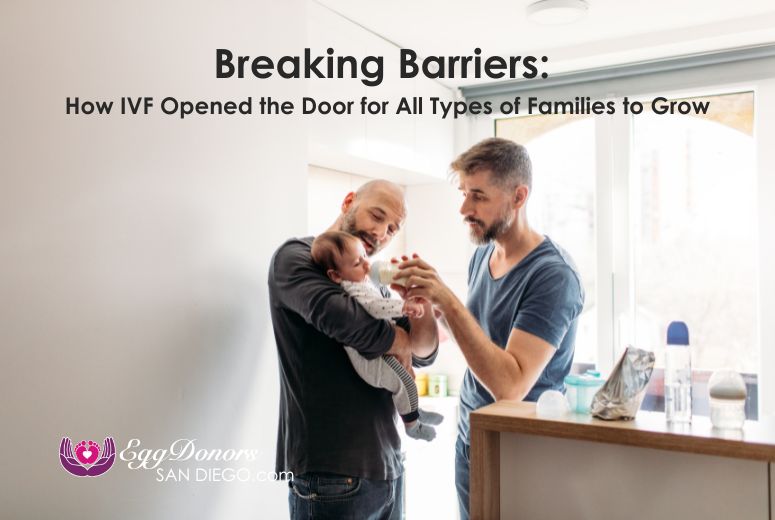When Louise Brown was born on July 25, 1978, she became the world’s first IVF baby—a title that would forever redefine what was possible in reproductive medicine. Her birth was more than a scientific feat; it marked a pivotal shift in the history of IVF, offering new hope for families who had long faced infertility in silence.
Today, IVF treatment continues to evolve as a powerful, inclusive force in fertility care. From single parents and same-sex couples to individuals with complex medical conditions, in vitro fertilization has created space for all types of families to grow—safely, compassionately, and on their own terms.
“The beauty of IVF today lies in its versatility,” explains Dr. Minoos Hosseinzadeh, Founder and Medical Director of EggDonorsSanDiego.com and the Fertility Institute of San Diego. “We’ve gone from helping couples with blocked fallopian tubes to empowering LGBTQ+ individuals, cancer survivors, and more to build the families they’ve always dreamed of.”
IVF Treatment Defined: A Gateway to Parenthood
IVF treatment, short for in vitro fertilization, is a multi-step medical process that involves retrieving eggs from the ovaries, inseminating them with sperm in a laboratory, and transferring a resulting embryo into a prepared uterus.
Initially created for patients with tubal factor infertility, IVF is now a central part of modern infertility treatment options. It has expanded access to parenthood for those facing a broad spectrum of medical, social, and genetic barriers.
Today’s IVF technology includes:
- Advanced medications for individualized medical protocols
- Preimplantation Genetic Testing (PGT) for chromosomal abnormalities
- Time-lapse embryo imaging
- Egg and embryo cryopreservation
- Donor eggs, donor sperm, and gestational carriers
Each advancement has contributed to rising IVF success rates, even among patients once considered unlikely candidates.
The History of IVF: From Breakthrough to Mainstream
The history of IVF began with groundbreaking work by Dr. Patrick Steptoe and Dr. Robert Edwards in England. Their collaboration led to the conception of Louise Brown, born via laparoscopic egg retrieval and laboratory fertilization—a process that would go on to influence global reproductive medicine.
In the early years, IVF was often met with skepticism, moral debate, and regulatory barriers. Yet as success stories mounted and protocols improved, its place in mainstream medicine solidified.
“Louise Brown’s birth wasn’t just a medical event—it was a symbol of possibility,” says Dr. Hosseinzadeh. “It invited us to rethink what defines a family, and who deserves access to the tools of fertility care. The answer is everyone.”
Evolution of Fertility Care: Who Benefits Today?
One of the most powerful aspects of IVF treatment is its ability to serve families of all backgrounds. Here’s how IVF is breaking down reproductive barriers:
LGBTQ+ Couples and Individuals
- Same-sex male couples can pursue IVF with egg donation and gestational surrogacy
- Same-sex female couples may alternate roles between egg provider and the other partner carrying the baby
- Transgender individuals can preserve fertility through egg or sperm freezing prior to transition
Single Parents by Choice
- Single women may use donor sperm with IVF for increased control over fertilization and embryo quality
- Single men can use egg donation and surrogacy to become biological fathers
Medical Conditions and Fertility Preservation
- Cancer patients can preserve eggs, sperm, or embryos prior to chemotherapy
- Individuals with endometriosis, PCOS, low ovarian reserve, or male-factor infertility benefit from tailored IVF protocols
Older Patients or Complex Cases
- IVF allows for embryo banking and PGT-A testing, improving pregnancy chances for patients over 40
- Donor egg programs help patients with diminished ovarian function still achieve motherhood
Each of these scenarios reflects a core truth: IVF isn’t just about overcoming biology. It’s about honoring identity, choice, and supporting the human right to parent.
Breakthroughs in IVF Technology
Today’s advances in reproductive medicine are nothing short of extraordinary. Clinics like EggDonorsSanDiego.com leverage:
- Artificial intelligence for embryo selection
- Preimplantation genetic testing for embryo viability & gender selection
- Optimized lab conditions that mimic the uterine environment
- Integrated egg donor databases for personalized matching
“The progress we’ve seen in fertility science is stunning,” notes Dr. Hosseinzadeh. “We now routinely achieve success rates that were once thought impossible, especially when combined with careful customization of care.”
These breakthroughs in IVF not only boost outcomes but minimize physical burden, especially for egg donors and gestational carriers—critical partners in third-party reproduction.
Ethical Considerations in IVF
While technology surges forward, ethical discourse around IVF remains essential. Debates include:
- Embryo disposition and long-term storage
- Regulation of donor anonymity and donor conceived children’s rights
- Equity of access to care across socioeconomic backgrounds
- Reproductive tourism and jurisdictional discrepancies
“Every embryo represents a possibility. As stewards of that potential, we have a responsibility to ensure that IVF is practiced ethically, inclusively, and with full respect for all participants involved,” says Dr. Hosseinzadeh.
The Global Impact of IVF
More than 12 million babies have been born via IVF since Louise Brown. In some countries, nearly 5–10% of all births now result from assisted reproductive technologies. The global impact of IVF has expanded reproductive rights, influenced public policy, and prompted new legal frameworks to support nontraditional families.
At EggDonorsSanDiego.com, global outreach remains a key priority. The clinic regularly supports international patients seeking care in the U.S., particularly those facing restrictive laws in their home countries.
Looking Ahead: The Future of IVF
The future of IVF holds exciting potential:
- Stem-cell-derived gametes to help individuals with no viable eggs or sperm
- Uterine transplantation for women with uterine factor infertility
- Gene editing research (though controversial and highly regulated)
- Cross-platform integration with wearable technology for hormone tracking
Still, one constant remains—patient-centered care.
“Despite all the innovation, what truly matters is listening,” Dr. Hosseinzadeh says. “We personalize each journey with the understanding that behind every IVF cycle is a person, a family, a dream.”
FAQs: IVF Treatment and Family Diversity
Absolutely not. IVF is now used by LGBTQ+ individuals, single parents, and diverse family structures worldwide.
Not always. It depends on the medical and personal circumstances of the intended parent(s).
IVF occurs in a lab with egg and sperm combined outside the body. IUI places sperm directly into the uterus. IVF has higher success rates, especially in complex cases.
Using PGT-A, donor eggs, and customized stimulation protocols can significantly improve outcomes for patients over 40.
If you’re ready to start your egg donation journey, click here









